-
 Katsukawa Shun'ei (勝川 春英; 1762 – 1819).TITLE: Sawamura Sôjûrô III as Kakogawa Honzô.SERIES: Kanadehon Chūshingura (Kana practice book: Treasury of the loyal retainers").DATE: 1795Signed: Shun'ei ga (春英画). Publisher: Iwatoya Kisaburō, Marks 173/p.169. Vertical Ōban: 14.75 x 9.625 inchOn 4th lunar month of 1795 Sôjûrô plays the roles of En'ya Hangan and Kakogawa Honzô in the drama "Kanadehon Chûshingura" at Miyakoza theater in Edo.
Katsukawa Shun'ei (勝川 春英; 1762 – 1819).TITLE: Sawamura Sôjûrô III as Kakogawa Honzô.SERIES: Kanadehon Chūshingura (Kana practice book: Treasury of the loyal retainers").DATE: 1795Signed: Shun'ei ga (春英画). Publisher: Iwatoya Kisaburō, Marks 173/p.169. Vertical Ōban: 14.75 x 9.625 inchOn 4th lunar month of 1795 Sôjûrô plays the roles of En'ya Hangan and Kakogawa Honzô in the drama "Kanadehon Chûshingura" at Miyakoza theater in Edo. -
 Print by Katsukawa Shun'ei that presumably depicts a kabuki actor Ichikawa Monnosuke II. I was not able to find any reference of the image. Size: Hosoban. SOLD
Print by Katsukawa Shun'ei that presumably depicts a kabuki actor Ichikawa Monnosuke II. I was not able to find any reference of the image. Size: Hosoban. SOLD -
 Katsukawa Shun'ei. Signed: Shun'ei ga (春英画). Vertical Ōban. No reference whatsoever. Unidentified play, actors, roles, year, theatre. SOLD
Katsukawa Shun'ei. Signed: Shun'ei ga (春英画). Vertical Ōban. No reference whatsoever. Unidentified play, actors, roles, year, theatre. SOLD -
 An unsigned print, presumably by Katsukawa Shunshō that presumably depicts a kabuki actor Ichikawa Monnosuke II. I was not able to find any reference of the image. Size: Hosoban. According to The actor's image. Print makers of the Katsukawa School. Timothy T. Clark and Osamu Ueda with Donald Jenkins. Naomi Noble Richard, editor The Art Institute of Chicago in association with Princeton University Press, 1994, Ichikawa Monnosuke II was born in 1743, in Ōji Takinogawa, Edo. He died on October 19, 1974. His specialities were young male roles (wakashu) and male leads (tachi yaku). He was considered to be one of the four best young actors of his day.
An unsigned print, presumably by Katsukawa Shunshō that presumably depicts a kabuki actor Ichikawa Monnosuke II. I was not able to find any reference of the image. Size: Hosoban. According to The actor's image. Print makers of the Katsukawa School. Timothy T. Clark and Osamu Ueda with Donald Jenkins. Naomi Noble Richard, editor The Art Institute of Chicago in association with Princeton University Press, 1994, Ichikawa Monnosuke II was born in 1743, in Ōji Takinogawa, Edo. He died on October 19, 1974. His specialities were young male roles (wakashu) and male leads (tachi yaku). He was considered to be one of the four best young actors of his day. -
 Iron tsuba of round form with design of hatchet executed in openwork (sukashi) and three fan panels motif on both sides carved in low relief (sukidashi-bori). Designs on the fan panels - face: bellflower, plum blossom in mist, grass leaves; - back: clouds, grass, and half plum blossom in mist. Copper sekigane. Koga-hitsu-ana probably cut out on a later date. Kamakura or kamakura-bori school. Edo period. Height: 83.8 mm, Width: 82.2 mm, Thickness at seppa-dai: 3.2 mm. NBTHK certificate № 4005500: Hozon (worthy of preservation).
Iron tsuba of round form with design of hatchet executed in openwork (sukashi) and three fan panels motif on both sides carved in low relief (sukidashi-bori). Designs on the fan panels - face: bellflower, plum blossom in mist, grass leaves; - back: clouds, grass, and half plum blossom in mist. Copper sekigane. Koga-hitsu-ana probably cut out on a later date. Kamakura or kamakura-bori school. Edo period. Height: 83.8 mm, Width: 82.2 mm, Thickness at seppa-dai: 3.2 mm. NBTHK certificate № 4005500: Hozon (worthy of preservation). -
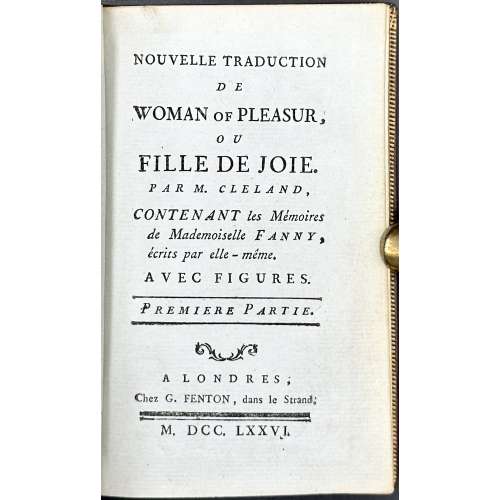 Hardcover volume, collated 18mo, 130 x 85 mm (2 parts in one). Contemporary burgundy morocco outlined with gilt triple fillet, flat spine gilt in compartments, brown morocco label gilt, all edges gilt, gilt dentelle, text printed on slightly blue laid paper with illegible watermark; dark blue endpapers, Tony Fekete (T. F.) bookplate by Wahorn to front pastedown. Frontispiece and 14 engraved plates by Elluin after Borel, with guard tissue. Graphite ms to h.t.: "Figures de Borrel. | Gravées pr. Elluin." Title-page: NOUVELLE TRADUCTION | DE | WOMAN OF PLEASUR, | OU | FILLE DE JOIE. | PAR M. CLELAND, | CONTENANT les Mémoires | de Mademoiselle FANNY, | écrits par elle – même. | AVEC FIGURES | — | PREMIERE (SECONDE) PARTIE. | — | ~ | A LONDRES; | Chez G. FENTON, dans le Strand; | — | M. DCC. LXXVI. || Collation: 18mo throughout A-O12/6, total 126 leaves plus 15 plates, incl. frontispiece. Pagination: separate for each part [1-5] 6-119 [120 blank], [1-3] 4-132, total 252 pages. Provenance: Tony Fekete (Christie’s 2014, № 54, p. 37; Price realized GBP 11,875): “[CLELAND, John (1709-1789).] Nouvelle traduction de Woman of Pleasur [sic] ou Fille de Joie. Contenant les Mémoires de Mademoiselle Fanny, écrits par elle-même. London [but Paris]: G. Fenton [Cazin], 1776. 2 volumes in one, duodecimo (128 x 80 mm). Printed on blue tinted paper. Frontispiece and 14 engraved plates on thick white paper by Elluin after Borel. (Short tear repaired in the margin of one plate, another plate with a faint dampstain touching the facing leaf of text.) Contemporary burgundy morocco, flat spine gilt in compartments, morocco label gilt, covers with a gilt triple fillet border, gilt edges, blue endpapers. THE MOST BEAUTIFUL 18TH-CENTURY ILLUSTRATED EDITION OF THIS CELEBRATED EROTIC NOVEL. An excellent copy bound in contemporary morocco. It is the second translation into French, but the first to include the exquisite plates by Elluin after Borel. These are some of the best illustrations by this remarkable partnership responsible for a number of important 18th-century libertine texts. Cohen-DeRicci 242-3; Dutel A-407 ; Gay-Lemonnyer II, 304; Pia Enfer, 915.” Catalogue raisonné: Dutel (I) A-407, p. 134; Cohen-DeRicci 242-3; Fekete (Christie's) 54, p. 37. Contributors: John Cleland (British, c. 1709 – 1789). François-Rolland Elluin (French, 1745 – c. 1822) Antoine Borel (French, 1743 – 1810) Hubert-Martin Cazin (French, 1724 – 1795) András Wahorn (Hungarian, b. 1953) Fekete, Tony Laszlo (Hungarian, b. 1972)
Hardcover volume, collated 18mo, 130 x 85 mm (2 parts in one). Contemporary burgundy morocco outlined with gilt triple fillet, flat spine gilt in compartments, brown morocco label gilt, all edges gilt, gilt dentelle, text printed on slightly blue laid paper with illegible watermark; dark blue endpapers, Tony Fekete (T. F.) bookplate by Wahorn to front pastedown. Frontispiece and 14 engraved plates by Elluin after Borel, with guard tissue. Graphite ms to h.t.: "Figures de Borrel. | Gravées pr. Elluin." Title-page: NOUVELLE TRADUCTION | DE | WOMAN OF PLEASUR, | OU | FILLE DE JOIE. | PAR M. CLELAND, | CONTENANT les Mémoires | de Mademoiselle FANNY, | écrits par elle – même. | AVEC FIGURES | — | PREMIERE (SECONDE) PARTIE. | — | ~ | A LONDRES; | Chez G. FENTON, dans le Strand; | — | M. DCC. LXXVI. || Collation: 18mo throughout A-O12/6, total 126 leaves plus 15 plates, incl. frontispiece. Pagination: separate for each part [1-5] 6-119 [120 blank], [1-3] 4-132, total 252 pages. Provenance: Tony Fekete (Christie’s 2014, № 54, p. 37; Price realized GBP 11,875): “[CLELAND, John (1709-1789).] Nouvelle traduction de Woman of Pleasur [sic] ou Fille de Joie. Contenant les Mémoires de Mademoiselle Fanny, écrits par elle-même. London [but Paris]: G. Fenton [Cazin], 1776. 2 volumes in one, duodecimo (128 x 80 mm). Printed on blue tinted paper. Frontispiece and 14 engraved plates on thick white paper by Elluin after Borel. (Short tear repaired in the margin of one plate, another plate with a faint dampstain touching the facing leaf of text.) Contemporary burgundy morocco, flat spine gilt in compartments, morocco label gilt, covers with a gilt triple fillet border, gilt edges, blue endpapers. THE MOST BEAUTIFUL 18TH-CENTURY ILLUSTRATED EDITION OF THIS CELEBRATED EROTIC NOVEL. An excellent copy bound in contemporary morocco. It is the second translation into French, but the first to include the exquisite plates by Elluin after Borel. These are some of the best illustrations by this remarkable partnership responsible for a number of important 18th-century libertine texts. Cohen-DeRicci 242-3; Dutel A-407 ; Gay-Lemonnyer II, 304; Pia Enfer, 915.” Catalogue raisonné: Dutel (I) A-407, p. 134; Cohen-DeRicci 242-3; Fekete (Christie's) 54, p. 37. Contributors: John Cleland (British, c. 1709 – 1789). François-Rolland Elluin (French, 1745 – c. 1822) Antoine Borel (French, 1743 – 1810) Hubert-Martin Cazin (French, 1724 – 1795) András Wahorn (Hungarian, b. 1953) Fekete, Tony Laszlo (Hungarian, b. 1972) -
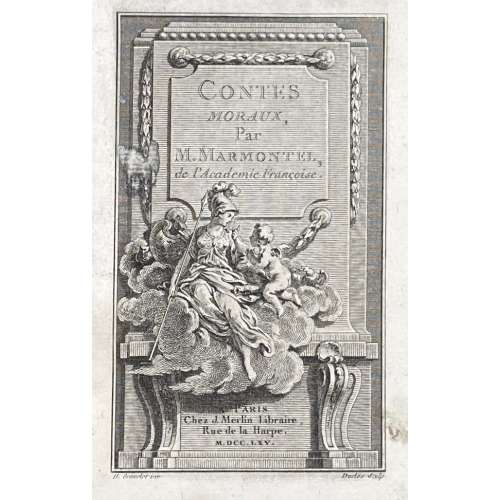 Engraved title-page: Contes | Moraux | Par | M. Marmontel, | de l'Academie Françoise. | A Paris | Chez J. Merlin Libraire, | Rue de la Harpe, | M DCC LXV ||Description: 3 volumes, 8vo, 20.4 x 13 cm, first issue, bound in the contemporary speckled calf, all edges gilt, spines gilt with double red/brown lettering labels (vol 1. labels missing); raised bands, gilt in compartments, double gilt-ruled borders; marbled endpapers. With the contemporary signature in each volume of Caroline Marlborough of Blenheim Palace, and bookplates of Lord F. A. Spencer. This is certainly Lady Caroline Russell, wife of George Spencer, Fourth Duke of Marlborough; she was daughter to the Duke of Bedford and was married in 1762. She died at Blenheim in 1811. The later bookplate in each volume pasted to the front pastedown of her son Francis Almeric Spencer (British, 1779-1845). Pagination: Vol. I: [two blank leaves] [half-title, verso blank] [recto blank, frontispiece on verso: portrait of Marmontel by St. Aubin after Cochin] [engraved t.p. by Duclos after Gravelot, verso blank], [i] ii-xvi, [table des contes with 5-line Errata (autograph Lordine Marlborough), verso blank], [1] 2–345 [346-50 blanks]; 9 plates after Gravelot by: Baquoy, de Longueil (2), Legrand, Leveau (2), Rousseau, Voyez, and unsigned (1). Vol. 2: [two blank leaves] [half-title, verso blank] [engraved t.p. by Duclos after Gravelot, verso blank] [table des contes with 10-line Errata (autograph Lordine Marlborough), verso blank], [1] 2–376 [377-50 blanks]; 9 plates after Gravelot by: de Longueil (5), Leveau (2), Pasquier and Rousseau. Vol. 3: [two blank leaves] [half-title, verso blank] [engraved t.p. by Duclos after Gravelot, verso blank] [table des contes with 9-line Errata, verso blank] [two leaves: approbation and Privilege du Roi] [1] 2–312 [313-16 blanks]; 5 plates after Gravelot by: de Longueil (2), Le Mire (2), and Pasquier. Catalogue raisonné: Cohen-De Ricci 686-7; Gordon N. Ray. The Art of the French Illustrated Book 1700 to 1914. — NY, London: The Pierpont Morgan Library; Cornell University Press, 1982, Vol. 1. pp. 44-5. [In their copy vol. 2 and 3 in a different order]; MFA ACCESSION NUMBER 37.1488a-c Illustrated by: Hubert François Gravelot (French, 1699–1773) Engraved by: Jean Charles Baquoy (French, 1721–1777) Engraved by: Antoine Jean Duclos (French, 1742–1795) Engraved by: Louis Legrand (French, 1723–1807) Engraved by: Noël Le Mire (French, 1724–1801) Engraved by: Jean Jacques André Le Veau (French, 1729–1785) Engraved by: Joseph de Longueil (French, 1730–1792) Engraved by: Jean Jacques Pasquier (French, died in 1785) Engraved by: Jean François Rousseau (French, born in 1740) Engraved by: Nicolas Joseph Voyez l'ainé (French, 1742–1806) Portrait(s) designed by: Charles-Nicolas Cochin le fils (French, 1715–1790) Engraved by: Augustin de Saint-Aubin (French, 1736–1807) Author: Jean-François Marmontel (French, 1723–1799) Publisher: Joseph Merlin (French, 1718–1783) Printer: Pierre-Alexandre Le Prieur (French, born in 1722)
Engraved title-page: Contes | Moraux | Par | M. Marmontel, | de l'Academie Françoise. | A Paris | Chez J. Merlin Libraire, | Rue de la Harpe, | M DCC LXV ||Description: 3 volumes, 8vo, 20.4 x 13 cm, first issue, bound in the contemporary speckled calf, all edges gilt, spines gilt with double red/brown lettering labels (vol 1. labels missing); raised bands, gilt in compartments, double gilt-ruled borders; marbled endpapers. With the contemporary signature in each volume of Caroline Marlborough of Blenheim Palace, and bookplates of Lord F. A. Spencer. This is certainly Lady Caroline Russell, wife of George Spencer, Fourth Duke of Marlborough; she was daughter to the Duke of Bedford and was married in 1762. She died at Blenheim in 1811. The later bookplate in each volume pasted to the front pastedown of her son Francis Almeric Spencer (British, 1779-1845). Pagination: Vol. I: [two blank leaves] [half-title, verso blank] [recto blank, frontispiece on verso: portrait of Marmontel by St. Aubin after Cochin] [engraved t.p. by Duclos after Gravelot, verso blank], [i] ii-xvi, [table des contes with 5-line Errata (autograph Lordine Marlborough), verso blank], [1] 2–345 [346-50 blanks]; 9 plates after Gravelot by: Baquoy, de Longueil (2), Legrand, Leveau (2), Rousseau, Voyez, and unsigned (1). Vol. 2: [two blank leaves] [half-title, verso blank] [engraved t.p. by Duclos after Gravelot, verso blank] [table des contes with 10-line Errata (autograph Lordine Marlborough), verso blank], [1] 2–376 [377-50 blanks]; 9 plates after Gravelot by: de Longueil (5), Leveau (2), Pasquier and Rousseau. Vol. 3: [two blank leaves] [half-title, verso blank] [engraved t.p. by Duclos after Gravelot, verso blank] [table des contes with 9-line Errata, verso blank] [two leaves: approbation and Privilege du Roi] [1] 2–312 [313-16 blanks]; 5 plates after Gravelot by: de Longueil (2), Le Mire (2), and Pasquier. Catalogue raisonné: Cohen-De Ricci 686-7; Gordon N. Ray. The Art of the French Illustrated Book 1700 to 1914. — NY, London: The Pierpont Morgan Library; Cornell University Press, 1982, Vol. 1. pp. 44-5. [In their copy vol. 2 and 3 in a different order]; MFA ACCESSION NUMBER 37.1488a-c Illustrated by: Hubert François Gravelot (French, 1699–1773) Engraved by: Jean Charles Baquoy (French, 1721–1777) Engraved by: Antoine Jean Duclos (French, 1742–1795) Engraved by: Louis Legrand (French, 1723–1807) Engraved by: Noël Le Mire (French, 1724–1801) Engraved by: Jean Jacques André Le Veau (French, 1729–1785) Engraved by: Joseph de Longueil (French, 1730–1792) Engraved by: Jean Jacques Pasquier (French, died in 1785) Engraved by: Jean François Rousseau (French, born in 1740) Engraved by: Nicolas Joseph Voyez l'ainé (French, 1742–1806) Portrait(s) designed by: Charles-Nicolas Cochin le fils (French, 1715–1790) Engraved by: Augustin de Saint-Aubin (French, 1736–1807) Author: Jean-François Marmontel (French, 1723–1799) Publisher: Joseph Merlin (French, 1718–1783) Printer: Pierre-Alexandre Le Prieur (French, born in 1722) -
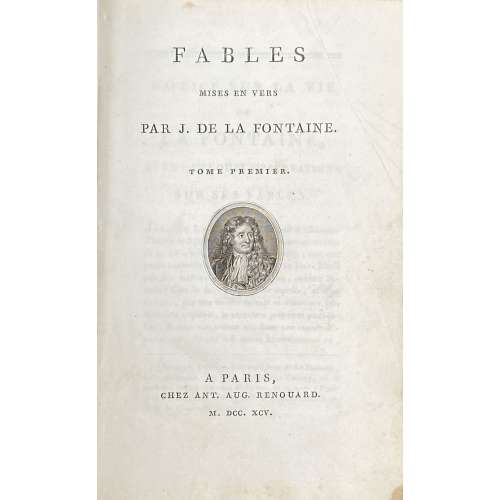 Two 8vo volumes bound in one, 19 x 12.5 cm, in full mottled sheepskin with gilt-bordered boards, gilt decorated flat spine with gilt-lettered red and black calf labels, rebacked, marbled endpapers and edges, printed on wove paper, plates on thicker laid paper. Title-page: FABLES | MISES EN VERS | PAR J. DE LA FONTAINE. | TOME PREMIER (SECOND). | {medallion portrait} (printer’s device “PC”) | A PARIS, | CHEZ ANT. AUG. RENOUARD. | M. DCC. XCV. || Collation: Vol. 1: π2 (h.t./imprint, t.p. medallion portrait/blank), [1]-38 (Notice sur la vie…), 1-58 64 (Vie de la Fontaine, Épitre, Préface, Vie d’Ésope), [7]-148 156 χ3 (table); pagination [4] [i] ii-xlviii, [1] 2-234. Total 143 leaves (286 pages) plus 6 plates after Moreau le Jeune by Devilliers fratres (p. 112), E. De Ghendt (pp. 122 and 181), Jean Louis Delignon (p. 140), Delvaux (p. 197), and Ph. Trière (p. 219). Title medallion portrait of La Fontaine (G Rigault pinx. – C S Gaucher inc.) by Gaucher after Rigaud. Vol. 2: π2 1-158 164; pagination [4] [1] 2-247 [248 blank]. Total 126 leaves (252 pages) plus 6 plates after Moreau le Jeune by Devilliers fratres (p. 19), Villerey (pp. 37, 80, and 146), Bosq (p. 121), and Ph. Trière (p. 199). The book published in 1795 (An 3) supplemented with plates produced in 1811 and 1812 for Œuvres complèttes (sic) de Jean de la Fontaine published by Lefèvre in 1814. The reason for choosing this particular edition for someone's library shortly after 1814 was probably the absence of censorship in 1795. Catalogue raisonné: (1) Lewine [LIB-2538.2020] on p. 276 (Paris, chez Renouard, 1795, 2 vols., 8vo., medal portrait on first title, and 12 plates after Moreau by Delvaux, Bosq, Ghendt, Trière, and Villerey). (2) M.-J.-F. Mahérault. L' oeuvre de Moreau le Jeune : catalogue raisonné et descriptif avec notes iconographiques et bibliographiques. — Paris: A. Labitte, 1880. Contributors: Jean de La Fontaine (French, 1621–1695) – author. Jean-Michel Moreau le Jeune (French, 1741–1814) – artist. Hyacinthe Rigaud (French, 1659 – 1743) – artist. Antoine-Augustin Renouard (French, 1765 – 1853) – publisher. Pierre Causse (French, 1761 – 1834) – printer. Engravers: Charles Étienne Gaucher (French, 1741 – 1804) Etienne De Villiers [Devilliers, Devilliers fratres] (French, 1784 – after 1844) Emmanuel Jean Nepomucène de Ghendt (Flemish, worked in France, 1738 – 1815) Jean-Louis Delignon (French, 1755 – 1820) Rémi Henri Joseph Delvaux (French, 1748 – 1823) Philippe Trière (French, 1756 – c. 1815) Auguste Villerey (French, 1801 – 1846) Jean Bosq (French, fl. c. 1801 – 1844)
Two 8vo volumes bound in one, 19 x 12.5 cm, in full mottled sheepskin with gilt-bordered boards, gilt decorated flat spine with gilt-lettered red and black calf labels, rebacked, marbled endpapers and edges, printed on wove paper, plates on thicker laid paper. Title-page: FABLES | MISES EN VERS | PAR J. DE LA FONTAINE. | TOME PREMIER (SECOND). | {medallion portrait} (printer’s device “PC”) | A PARIS, | CHEZ ANT. AUG. RENOUARD. | M. DCC. XCV. || Collation: Vol. 1: π2 (h.t./imprint, t.p. medallion portrait/blank), [1]-38 (Notice sur la vie…), 1-58 64 (Vie de la Fontaine, Épitre, Préface, Vie d’Ésope), [7]-148 156 χ3 (table); pagination [4] [i] ii-xlviii, [1] 2-234. Total 143 leaves (286 pages) plus 6 plates after Moreau le Jeune by Devilliers fratres (p. 112), E. De Ghendt (pp. 122 and 181), Jean Louis Delignon (p. 140), Delvaux (p. 197), and Ph. Trière (p. 219). Title medallion portrait of La Fontaine (G Rigault pinx. – C S Gaucher inc.) by Gaucher after Rigaud. Vol. 2: π2 1-158 164; pagination [4] [1] 2-247 [248 blank]. Total 126 leaves (252 pages) plus 6 plates after Moreau le Jeune by Devilliers fratres (p. 19), Villerey (pp. 37, 80, and 146), Bosq (p. 121), and Ph. Trière (p. 199). The book published in 1795 (An 3) supplemented with plates produced in 1811 and 1812 for Œuvres complèttes (sic) de Jean de la Fontaine published by Lefèvre in 1814. The reason for choosing this particular edition for someone's library shortly after 1814 was probably the absence of censorship in 1795. Catalogue raisonné: (1) Lewine [LIB-2538.2020] on p. 276 (Paris, chez Renouard, 1795, 2 vols., 8vo., medal portrait on first title, and 12 plates after Moreau by Delvaux, Bosq, Ghendt, Trière, and Villerey). (2) M.-J.-F. Mahérault. L' oeuvre de Moreau le Jeune : catalogue raisonné et descriptif avec notes iconographiques et bibliographiques. — Paris: A. Labitte, 1880. Contributors: Jean de La Fontaine (French, 1621–1695) – author. Jean-Michel Moreau le Jeune (French, 1741–1814) – artist. Hyacinthe Rigaud (French, 1659 – 1743) – artist. Antoine-Augustin Renouard (French, 1765 – 1853) – publisher. Pierre Causse (French, 1761 – 1834) – printer. Engravers: Charles Étienne Gaucher (French, 1741 – 1804) Etienne De Villiers [Devilliers, Devilliers fratres] (French, 1784 – after 1844) Emmanuel Jean Nepomucène de Ghendt (Flemish, worked in France, 1738 – 1815) Jean-Louis Delignon (French, 1755 – 1820) Rémi Henri Joseph Delvaux (French, 1748 – 1823) Philippe Trière (French, 1756 – c. 1815) Auguste Villerey (French, 1801 – 1846) Jean Bosq (French, fl. c. 1801 – 1844) -
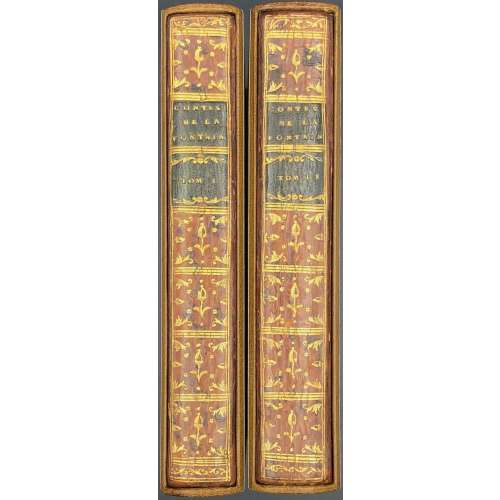 Two-volume edition, financed, arranged and managed by Fermiers généraux. Vol. 1. Title : CONTES | ET | NOUVELLES | EN VERS, | Par M. de La Fontaine. | TOME I. | {vignette} | A AMSTERDAM. | — | M. DCC. LXII. || Pagination: [2] – blanks [i, ii] – h.t. / blank, [iii, iv] – t.p. / blank, v-xiv, [1] 2–268 [269-70] – table, [4] – blanks, plus frontispiece by Fiquet after Rigault, t.p. vignette, vignette, headpiece, and 23 tailpieces by Choffard, 39 plates by various engravers after Charles Eisen. Vol. 2. Title: same but TOME II. Pagination: [2] – blanks] [i, ii] – h.t. / blank, [iii] iv-viii [1] 2–306 [307-10] – épitaphe / table, [4] – blanks, plus frontispiece by Fiquet after Vispré, t.p. vignette, vignette, headpiece, and 29 tailpieces by Choffard, and 42 plates after Charles Eisen (Ray only cite 41 plates). Binding: 2 volumes, 19.8 x 12.2 each, uniformly bound in full Spanish mottled calf, boards triple ruled in gilt, flat spine with triple bands, double ruled and tooled in gilt, black title labels lettered in gilt, all margins gilt, marbled end-papers, in cardboard slipcases, openings leathered. In vol. 1 a manuscript plate 4.8 x 8.2 cm pasted to page [1]: "Cette Édition est très rare n’y ayant | eu que 30 Exemplaires de livres, ou la figure principale dans le Cas de Conscience page 143 Tom 2 est nud tandis que dans les autres Éditions cette Figure est voilée par un feuillage".
Two-volume edition, financed, arranged and managed by Fermiers généraux. Vol. 1. Title : CONTES | ET | NOUVELLES | EN VERS, | Par M. de La Fontaine. | TOME I. | {vignette} | A AMSTERDAM. | — | M. DCC. LXII. || Pagination: [2] – blanks [i, ii] – h.t. / blank, [iii, iv] – t.p. / blank, v-xiv, [1] 2–268 [269-70] – table, [4] – blanks, plus frontispiece by Fiquet after Rigault, t.p. vignette, vignette, headpiece, and 23 tailpieces by Choffard, 39 plates by various engravers after Charles Eisen. Vol. 2. Title: same but TOME II. Pagination: [2] – blanks] [i, ii] – h.t. / blank, [iii] iv-viii [1] 2–306 [307-10] – épitaphe / table, [4] – blanks, plus frontispiece by Fiquet after Vispré, t.p. vignette, vignette, headpiece, and 29 tailpieces by Choffard, and 42 plates after Charles Eisen (Ray only cite 41 plates). Binding: 2 volumes, 19.8 x 12.2 each, uniformly bound in full Spanish mottled calf, boards triple ruled in gilt, flat spine with triple bands, double ruled and tooled in gilt, black title labels lettered in gilt, all margins gilt, marbled end-papers, in cardboard slipcases, openings leathered. In vol. 1 a manuscript plate 4.8 x 8.2 cm pasted to page [1]: "Cette Édition est très rare n’y ayant | eu que 30 Exemplaires de livres, ou la figure principale dans le Cas de Conscience page 143 Tom 2 est nud tandis que dans les autres Éditions cette Figure est voilée par un feuillage".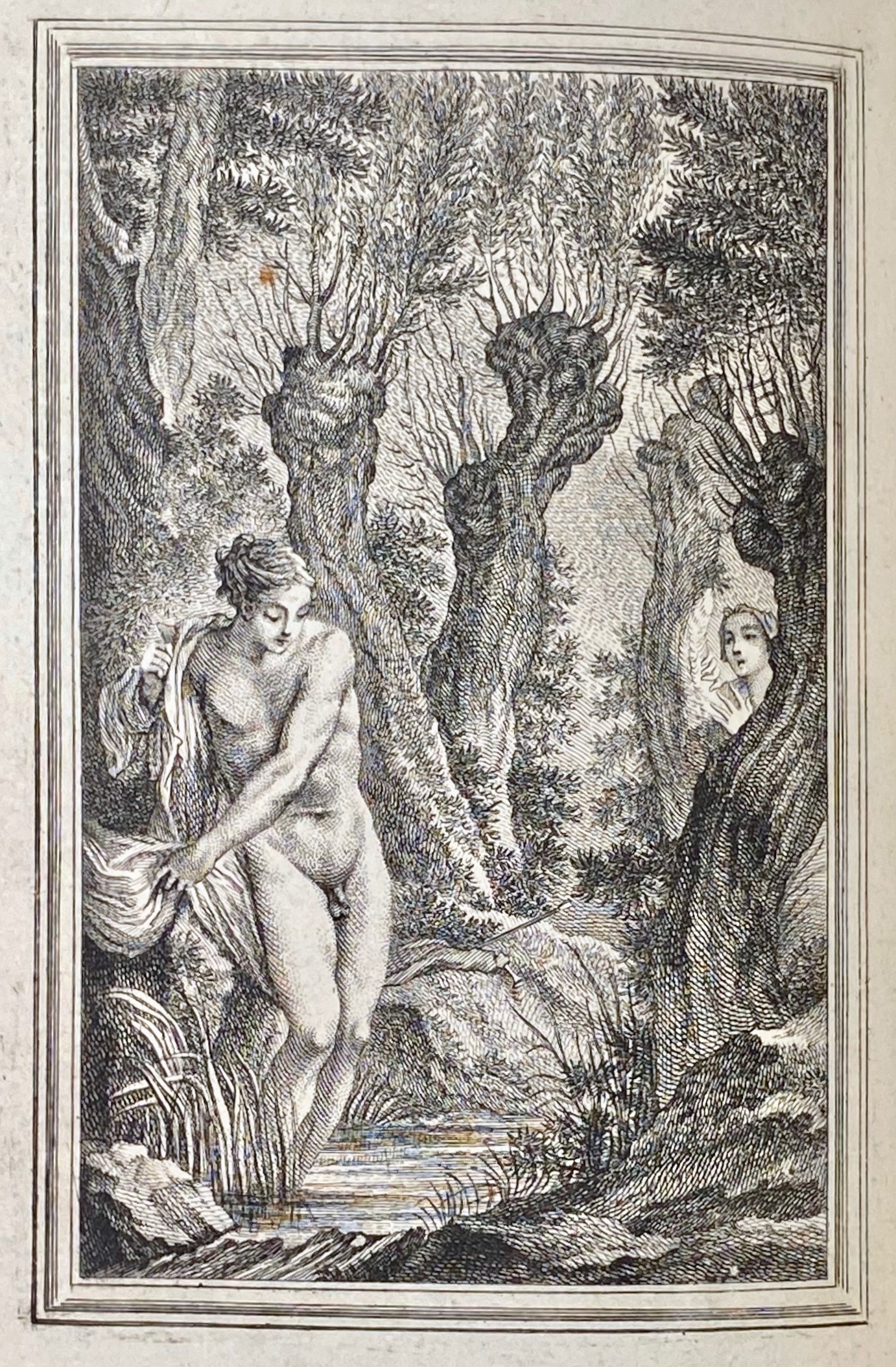
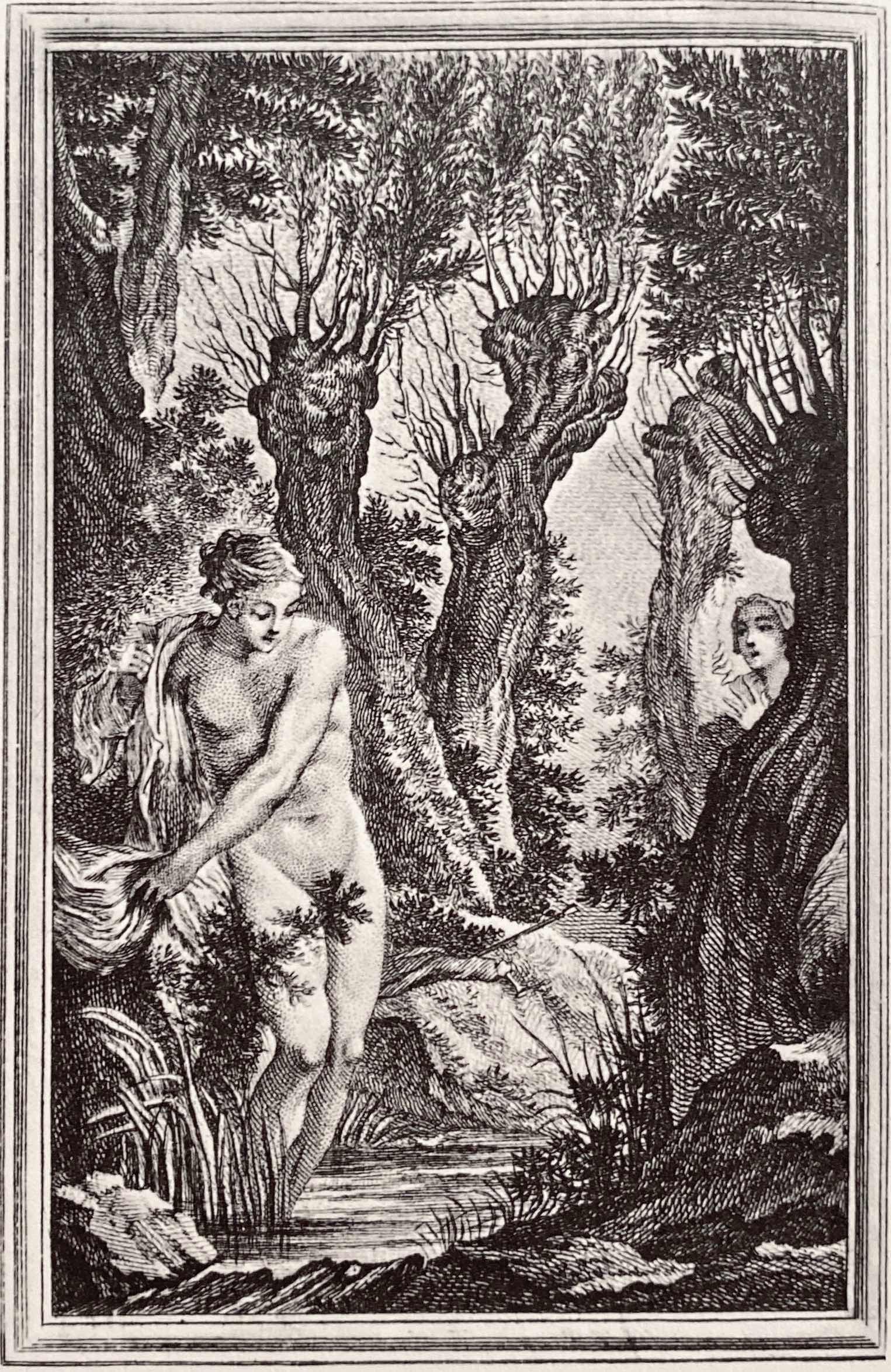 Contributors:
Jean de La Fontaine (French, 1621–1695) – author.
Fermiers généraux and Jean Baptiste Séroux d'Agincourt (French, 1730 – 1814) – publisher.
Joseph Gérard Barbou (French, 1723–1790) – printer.
Artists:
Charles Eisen (French, 1720 – 1778)
François Xavier Vispré (British-French, c.1730 – 1789 or after)
Hyacinthe Rigaud [Jacint Rigau-Ros i Serra] (Catalan-French, 1659 – 1743)
Engravers:
Joseph de Longueil (French, 1730 – 1792)
Noël Le Mire (French, 1724 – 1801)
Jean-Jacques André Le Veau (French, 1729 – 1786)
Jacques Aliamet (French, 1726 – 1788)
Jean Charles Baquoy (French, 1721 – 1777)
Pierre-Philippe Choffard (French, 1730 – 1809)
Jean Jacques Flipart (French, 1719 – 1782)
Louis Simon Lempereur (French, 1725 – 1796)
Jean Ouvrier (French, 1725 – 1784)
Contributors:
Jean de La Fontaine (French, 1621–1695) – author.
Fermiers généraux and Jean Baptiste Séroux d'Agincourt (French, 1730 – 1814) – publisher.
Joseph Gérard Barbou (French, 1723–1790) – printer.
Artists:
Charles Eisen (French, 1720 – 1778)
François Xavier Vispré (British-French, c.1730 – 1789 or after)
Hyacinthe Rigaud [Jacint Rigau-Ros i Serra] (Catalan-French, 1659 – 1743)
Engravers:
Joseph de Longueil (French, 1730 – 1792)
Noël Le Mire (French, 1724 – 1801)
Jean-Jacques André Le Veau (French, 1729 – 1786)
Jacques Aliamet (French, 1726 – 1788)
Jean Charles Baquoy (French, 1721 – 1777)
Pierre-Philippe Choffard (French, 1730 – 1809)
Jean Jacques Flipart (French, 1719 – 1782)
Louis Simon Lempereur (French, 1725 – 1796)
Jean Ouvrier (French, 1725 – 1784)
Étienne Ficquet (French 1719 – 1794)
Catalogue raisonné: Ray (French): №26, pp. 54-56; Cohen-DeRicci: 558-571; Lewine: 278-280. -
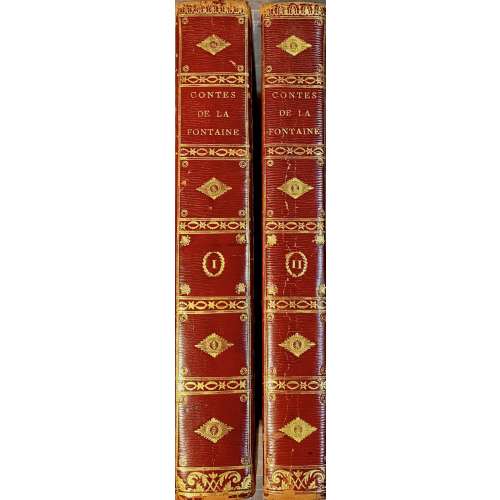 Two-volume large paper edition with 20 plates in two states. Vol. 1 (with plates). Title : CONTES | ET | NOUVELLES EN VERS. | PAR | JEAN DE LA FONTAINE. | — | TOME PREMIER| {vignette “P.P. Choffard 95”} | A PARIS, | DE L’IMPRIMERIE DE P. DIDOT L'AÎNÉ. | L’AN III DE LA RÉPUBLIQUE. | M. DCC. XCV. || Pagination: [2] [i-iv] v-vii [viii], 1-280 [2 table] [2], total 294 pages, ils. Collation: 4to; 1 blank, π4 (π3a signed “a”), 1-354 361, 1 blank, total 147 leaves, plus 40 leaves of plates with tissue guards, after Fragonard and others, which represent 20 engravings, each in two states, before and after letters, besides №9 (Le Calendrier des Vieillards by Jean Dambrun after Fragonard), which has two identical copies, both before letters. Vol. 2. (without plates) Title: same, but TOME SECOND. Pagination: [2] [4] 1-334 [2], total 342 pages. Collation: 4to; 1 blank, π2 1-414 423 1 blank, total 167 leaves. Binding: Two volumes uniformly bound in crimson straight-grain morocco, ruled in gilt, gilt-decorated flat spine with lettering, board edges and turn-ins tooled with gilt dentelles, marbled endpapers, three bookplates to front pastedown, top edge trimmed, 2nd volume partly uncut; text and plates printed on thick Dutch wove paper. Size: volumes: 33.3 x 25.2 cm; leaves: 31.5 x 23.5 cm. Provenance: Bishop, Cortlandt Field (American, 1870 – 1935) – bookplate. Mary S. Collins – bookplate by J. H. Fincken. Robin F. Satinsky (American, 1919 – 2008) – Robin Collection bookplate. Catalogue raisonné: Ray (French): 133-137; Cohen-DeRicci 573-582 ; Lewine : 281-282. CONTRIBUTORS: Jean de La Fontaine (French, 1621–1695) – author. Pierre Didot (French, 1761–1853) – publisher, printer. Artists: Jean-Honoré Fragonard (French, 1732–1806) Jean Baptiste Mallet (French, 1759–1835) Jacques Louis François Touzé (French, 1747–1807) Charles Monnet (French, 1732–after 1808) Engravers: Jacques Aliamet (French, 1726–1788) Jean Dambrun (French, 1741–about 1808) Jean Louis Delignon (French, 1755–about 1804) Jean Baptiste Michel Dupréel (French, active 1787–1817) Louis Michel Halbou (French, 1730–1809) Charles Louis Lingée (French, 1748–1819) Charles Emmanuel Jean Baptiste Patas (French, 1744–1802) Jean Baptiste Simonet (French, 1742–1813) Jean Baptiste Tilliard (French, 1740–1823) Philippe Trière (French, 1756–about 1815) Pierre-Philippe Choffard (French, 1730–1809) – t.p. vignette PLATES (collation order): №8: Fragonard / Trière – La Gageure des trois Commères №1*: Fragonard / Lingée – Joconde №1**: Mallet / Trière – Joconde №2: Fragonard / Delignon – Le Cocu battu et content №3: Fragonard / Tilliard – Le Mari confesseur №4: Fragonard / Dambrun – Le Savetier №5: Fragonard / Lingée – Le Paysan qui avait offensé son Seigneur №9: Fragonard / Dambrun – Le Calendrier des Vieillards №10: Fragonard / Aliamet – A Femme avare galant Escroc №12: Fragonard / Halbou – Le Gascon puni №11: Fragonard / Patas – On ne s’avise jamais de tout №13: Monnet / Tilliard – La Fiancée du roi de Garbe №14: Fragonard / Dupréel – La Coupe enchantée №15: Fragonard / Tilliard – Le Faucon №17: Fragonard / Patas – Le Pâté d’Anguilles №18: Fragonard / Tilliard – Le Magnifique №19: Fragonard / Delignon – La Matrone d’Ephèse №20: Fragonard / Patas – Belphégor №22: Touzé / Simonet – Le Glouton №26: Touzé / Lingée – Le Baiser rendu
Two-volume large paper edition with 20 plates in two states. Vol. 1 (with plates). Title : CONTES | ET | NOUVELLES EN VERS. | PAR | JEAN DE LA FONTAINE. | — | TOME PREMIER| {vignette “P.P. Choffard 95”} | A PARIS, | DE L’IMPRIMERIE DE P. DIDOT L'AÎNÉ. | L’AN III DE LA RÉPUBLIQUE. | M. DCC. XCV. || Pagination: [2] [i-iv] v-vii [viii], 1-280 [2 table] [2], total 294 pages, ils. Collation: 4to; 1 blank, π4 (π3a signed “a”), 1-354 361, 1 blank, total 147 leaves, plus 40 leaves of plates with tissue guards, after Fragonard and others, which represent 20 engravings, each in two states, before and after letters, besides №9 (Le Calendrier des Vieillards by Jean Dambrun after Fragonard), which has two identical copies, both before letters. Vol. 2. (without plates) Title: same, but TOME SECOND. Pagination: [2] [4] 1-334 [2], total 342 pages. Collation: 4to; 1 blank, π2 1-414 423 1 blank, total 167 leaves. Binding: Two volumes uniformly bound in crimson straight-grain morocco, ruled in gilt, gilt-decorated flat spine with lettering, board edges and turn-ins tooled with gilt dentelles, marbled endpapers, three bookplates to front pastedown, top edge trimmed, 2nd volume partly uncut; text and plates printed on thick Dutch wove paper. Size: volumes: 33.3 x 25.2 cm; leaves: 31.5 x 23.5 cm. Provenance: Bishop, Cortlandt Field (American, 1870 – 1935) – bookplate. Mary S. Collins – bookplate by J. H. Fincken. Robin F. Satinsky (American, 1919 – 2008) – Robin Collection bookplate. Catalogue raisonné: Ray (French): 133-137; Cohen-DeRicci 573-582 ; Lewine : 281-282. CONTRIBUTORS: Jean de La Fontaine (French, 1621–1695) – author. Pierre Didot (French, 1761–1853) – publisher, printer. Artists: Jean-Honoré Fragonard (French, 1732–1806) Jean Baptiste Mallet (French, 1759–1835) Jacques Louis François Touzé (French, 1747–1807) Charles Monnet (French, 1732–after 1808) Engravers: Jacques Aliamet (French, 1726–1788) Jean Dambrun (French, 1741–about 1808) Jean Louis Delignon (French, 1755–about 1804) Jean Baptiste Michel Dupréel (French, active 1787–1817) Louis Michel Halbou (French, 1730–1809) Charles Louis Lingée (French, 1748–1819) Charles Emmanuel Jean Baptiste Patas (French, 1744–1802) Jean Baptiste Simonet (French, 1742–1813) Jean Baptiste Tilliard (French, 1740–1823) Philippe Trière (French, 1756–about 1815) Pierre-Philippe Choffard (French, 1730–1809) – t.p. vignette PLATES (collation order): №8: Fragonard / Trière – La Gageure des trois Commères №1*: Fragonard / Lingée – Joconde №1**: Mallet / Trière – Joconde №2: Fragonard / Delignon – Le Cocu battu et content №3: Fragonard / Tilliard – Le Mari confesseur №4: Fragonard / Dambrun – Le Savetier №5: Fragonard / Lingée – Le Paysan qui avait offensé son Seigneur №9: Fragonard / Dambrun – Le Calendrier des Vieillards №10: Fragonard / Aliamet – A Femme avare galant Escroc №12: Fragonard / Halbou – Le Gascon puni №11: Fragonard / Patas – On ne s’avise jamais de tout №13: Monnet / Tilliard – La Fiancée du roi de Garbe №14: Fragonard / Dupréel – La Coupe enchantée №15: Fragonard / Tilliard – Le Faucon №17: Fragonard / Patas – Le Pâté d’Anguilles №18: Fragonard / Tilliard – Le Magnifique №19: Fragonard / Delignon – La Matrone d’Ephèse №20: Fragonard / Patas – Belphégor №22: Touzé / Simonet – Le Glouton №26: Touzé / Lingée – Le Baiser rendu -
 Two volumes, 16.6 x 11.4 cm each, uniformly bound in sprinkled calf, spine with raised bands, gilt in compartments, with crimson and black gilt lettered labels. Ink inscription to title page of vol. 1: “Thomas Fry. St: John's, Oxford.” Vol. 1: Collation: 4to; π2 ✶2 a4 b3 A-Z4 2A-2E4 2F1, (total 124 leaves), plus frontispiece, 29 in-text vignettes. Pagination: [2] – h.t., [2] – t.p., [4] – preface, [i] ii-xiv – Vie de La Fontaine, [1] 2-224, [2] – table, (total 248 pages), ils. Vol. 2: Collation: 4to; π2 ✶3 A-Z4 2A-2K4 2L3, (total 140 leavs), 40 in-text vignettes. Pagination: [2] – h.t., [2] – t.p., [6] – preface, [1] 2-268, [2] – table, (total 280 pages), ils. Illustrations: frontispiece by Lebas (signature erased), Vie de La Fontaine headpiece by Fessard after Cochin, 2 fleurons on two title pages, 69 vignettes by Chedel, Fessard, and Ravenet after Cochin (not signed). Catalogue raisonné: Lewine: 278; Cohen-deRicci: 557-8. Contributors: Charles-Nicolas Cochin (French, 1715 – 1790) – artist. Engravers: Pierre Quentin Chedel (French, 1705 – 1763). Étienne Fessard (French, 1714 – 1774). Simon François Ravenet (French, 1706 – 1764). Jacques-Philippe Le Bas [Lebas] (French, 1707 – 1783). Provenance: Thomas Fry (British, 1718 – 1772) – English priest and academic, president of St John's College, Oxford from 1757.
Two volumes, 16.6 x 11.4 cm each, uniformly bound in sprinkled calf, spine with raised bands, gilt in compartments, with crimson and black gilt lettered labels. Ink inscription to title page of vol. 1: “Thomas Fry. St: John's, Oxford.” Vol. 1: Collation: 4to; π2 ✶2 a4 b3 A-Z4 2A-2E4 2F1, (total 124 leaves), plus frontispiece, 29 in-text vignettes. Pagination: [2] – h.t., [2] – t.p., [4] – preface, [i] ii-xiv – Vie de La Fontaine, [1] 2-224, [2] – table, (total 248 pages), ils. Vol. 2: Collation: 4to; π2 ✶3 A-Z4 2A-2K4 2L3, (total 140 leavs), 40 in-text vignettes. Pagination: [2] – h.t., [2] – t.p., [6] – preface, [1] 2-268, [2] – table, (total 280 pages), ils. Illustrations: frontispiece by Lebas (signature erased), Vie de La Fontaine headpiece by Fessard after Cochin, 2 fleurons on two title pages, 69 vignettes by Chedel, Fessard, and Ravenet after Cochin (not signed). Catalogue raisonné: Lewine: 278; Cohen-deRicci: 557-8. Contributors: Charles-Nicolas Cochin (French, 1715 – 1790) – artist. Engravers: Pierre Quentin Chedel (French, 1705 – 1763). Étienne Fessard (French, 1714 – 1774). Simon François Ravenet (French, 1706 – 1764). Jacques-Philippe Le Bas [Lebas] (French, 1707 – 1783). Provenance: Thomas Fry (British, 1718 – 1772) – English priest and academic, president of St John's College, Oxford from 1757. -
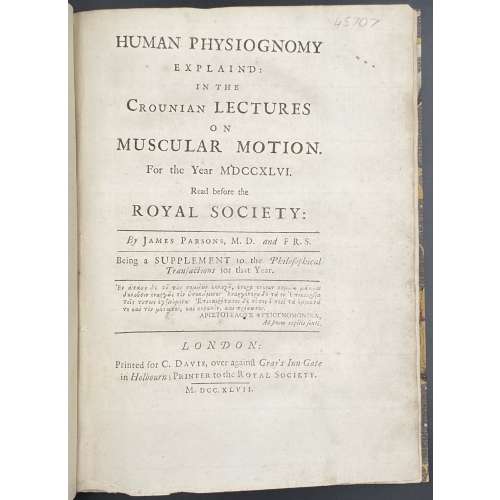 HUMAN PHYSIOGNOMY | EXPLAIN'D: | IN THE | Crounian LECTURES | ON MUSCULAR MOTION. | For the Year MDCCXLVI. | Read before the | ROYAL SOCIETY: | By James Parsons, M.D. and F.R.S. | Being a SUPPLEMENT to the Philosophical | Transactions for that Year. | {Citation in the Greek from Aristotle, 6 lines} | LONDON: | Printed for C. Davis, over against Gray's Inn Gate | in Holbourn; Printer to the Royal Society. | M. DCC. XLVII. || Pagination: [4] i-viii [8] 1-82 [4]; collation: 4to; [a]4 b4 c2 <inset> B-L4 M3, wanting 1 leaf with An Index For the Lectures of the Years 1744, and 1745; Inset: 5 folding plates engraved by J. Mynde after J. Parsons ('I. Ps. MD del.'). Page 22.5 x 16.5 cm; plates 22.5 x 34 cm. Printed on laid paper, with tall "s". Binding: 23 x 17 cm, modern hardcover in marbled paper, modern endpapers, white paper label with black lettering to spine. Crounian Lectures (i.e. Croonian Lectures), named after William Croone (British, 1633 – 1684). Contributors: James Parsons (British, 1705 – 1770). James Mynde (British, 1702 – 1771). Davis, Printer to the Royal Society of London (British, 1665 – 1775). Ref.: Royal Academy, The Royal Society, Wellcome Collection.
HUMAN PHYSIOGNOMY | EXPLAIN'D: | IN THE | Crounian LECTURES | ON MUSCULAR MOTION. | For the Year MDCCXLVI. | Read before the | ROYAL SOCIETY: | By James Parsons, M.D. and F.R.S. | Being a SUPPLEMENT to the Philosophical | Transactions for that Year. | {Citation in the Greek from Aristotle, 6 lines} | LONDON: | Printed for C. Davis, over against Gray's Inn Gate | in Holbourn; Printer to the Royal Society. | M. DCC. XLVII. || Pagination: [4] i-viii [8] 1-82 [4]; collation: 4to; [a]4 b4 c2 <inset> B-L4 M3, wanting 1 leaf with An Index For the Lectures of the Years 1744, and 1745; Inset: 5 folding plates engraved by J. Mynde after J. Parsons ('I. Ps. MD del.'). Page 22.5 x 16.5 cm; plates 22.5 x 34 cm. Printed on laid paper, with tall "s". Binding: 23 x 17 cm, modern hardcover in marbled paper, modern endpapers, white paper label with black lettering to spine. Crounian Lectures (i.e. Croonian Lectures), named after William Croone (British, 1633 – 1684). Contributors: James Parsons (British, 1705 – 1770). James Mynde (British, 1702 – 1771). Davis, Printer to the Royal Society of London (British, 1665 – 1775). Ref.: Royal Academy, The Royal Society, Wellcome Collection. -
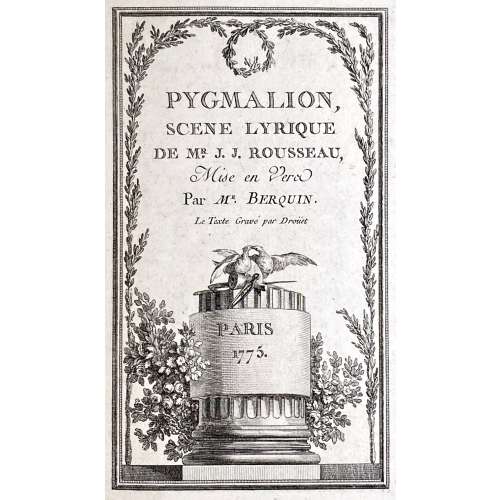 One volume, 22.8 x 15.5 cm, bound in full mottled calf, gilt floral frames to covers, raised bands and gilt fleurons to spine, printed on laid paper. Regarding Pygmalion, scène lyrique see: Wekipedia. Collation: Free endpaper and two blank flyleaves, [2] engraved title, [2] préface, 1-18 (Pygmalion), [2] f.t.p., [1] 2-8 (Idylle), two blank flyleaves and free endpaper; 20 leaves total, adorned with 7 headpieces and 1 tailpiece engraved by Nicolas de Launay, Nicolas Ponce and Charles Etienne Gaucher after Jean Michel Moreau the Younger and Clément Pierre Marillier; text engraved by Droüet. Title-page: PYGMALION, | SCENE LYRIQUE | DE MR. J. J. ROUSSEAU, | Mise en Vers | par MR. Berquin. | Le Text Gravé par Droüet | PARIS | 1775. || (on a column under two kissing doves and sculptor’s tools). Faux t.p.: IDYLLE | Par MR. Berquin. | — | Eructavit cor meum verbum bonum ; | dico ego opera mea regi. | Psalm. 44. | — || (in rules). Catalogue raisonné: Cohen-DeRicci 141 ; Lewine 55. Ref.: MFA (Boston); MET (NY); Yale University Library. Contributors: Artists: Jean-Michel Moreau le Jeune (French, 1741–1814) Clément Pierre Marillier (French, 1740–1808) Engravers: Nicolas Delaunay (French, 1739–1792) Charles-Étienne Gaucher (French, 1741–1804) Nicholas Ponce (French, 1746–1831) Droüet (French, 18th century) Authors: Arnaud Berquin (French, 1747–1791) Jean-Jacques Rousseau (French, 1712–1778)
One volume, 22.8 x 15.5 cm, bound in full mottled calf, gilt floral frames to covers, raised bands and gilt fleurons to spine, printed on laid paper. Regarding Pygmalion, scène lyrique see: Wekipedia. Collation: Free endpaper and two blank flyleaves, [2] engraved title, [2] préface, 1-18 (Pygmalion), [2] f.t.p., [1] 2-8 (Idylle), two blank flyleaves and free endpaper; 20 leaves total, adorned with 7 headpieces and 1 tailpiece engraved by Nicolas de Launay, Nicolas Ponce and Charles Etienne Gaucher after Jean Michel Moreau the Younger and Clément Pierre Marillier; text engraved by Droüet. Title-page: PYGMALION, | SCENE LYRIQUE | DE MR. J. J. ROUSSEAU, | Mise en Vers | par MR. Berquin. | Le Text Gravé par Droüet | PARIS | 1775. || (on a column under two kissing doves and sculptor’s tools). Faux t.p.: IDYLLE | Par MR. Berquin. | — | Eructavit cor meum verbum bonum ; | dico ego opera mea regi. | Psalm. 44. | — || (in rules). Catalogue raisonné: Cohen-DeRicci 141 ; Lewine 55. Ref.: MFA (Boston); MET (NY); Yale University Library. Contributors: Artists: Jean-Michel Moreau le Jeune (French, 1741–1814) Clément Pierre Marillier (French, 1740–1808) Engravers: Nicolas Delaunay (French, 1739–1792) Charles-Étienne Gaucher (French, 1741–1804) Nicholas Ponce (French, 1746–1831) Droüet (French, 18th century) Authors: Arnaud Berquin (French, 1747–1791) Jean-Jacques Rousseau (French, 1712–1778) -
 Isoda Koryūsai (礒田 湖龍斎, 1735–1790), flourished: 1769 to 1790. The print lacks signature (signature erased).
Isoda Koryūsai (礒田 湖龍斎, 1735–1790), flourished: 1769 to 1790. The print lacks signature (signature erased).Attributed definitely to Koryūsai: Jacob Pins, #491 [p.202] - Saigyo Hoshi admiring Mount Fuji. Signature erased but convincingly attributed to Koryusai. Tikotin Museum, Haifa. Catalogue raisonné: Allen Hockley: A3-J-5 (p. 261).
Saigyō Hōshi (西行 法師, 1118 – March 23, 1190) was a famous Japanese poet of the late Heian and early Kamakura period. -
 Evening Snow on Mount Hira (Hira no bosetsu), from the series Eight Views of Ōmi in Modern Guise (Ryaku Ōmi hakkei, (略近江八景). About 1773–75 (An'ei 2–4). Artist: Isoda Koryūsai (Japanese, 1735–1790) CATALOGUE RAISONNÉ: Hockley 2003, p. 202, #F-21-1 DIMENSIONS: Vertical chûban; 26 x 19.3 cm (10 1/4 x 7 5/8 in.)Signed: Koryû ga [湖竜画]
Evening Snow on Mount Hira (Hira no bosetsu), from the series Eight Views of Ōmi in Modern Guise (Ryaku Ōmi hakkei, (略近江八景). About 1773–75 (An'ei 2–4). Artist: Isoda Koryūsai (Japanese, 1735–1790) CATALOGUE RAISONNÉ: Hockley 2003, p. 202, #F-21-1 DIMENSIONS: Vertical chûban; 26 x 19.3 cm (10 1/4 x 7 5/8 in.)Signed: Koryû ga [湖竜画] -

Iron tsuba of oval form with the design of two immortals (Gama Sennin with the toad upon his head and Tekkai Sennin with his iron crutch) beside a waterfall carved in low relief with a high relief effect (takabori) and with details inlaid in gold. A waterfall carved on the reverse. Nakago-ana is plugged with copper sekigane. Unsigned. Allegedly, Mito School.
Edo period, ca. 1700.
Size: Height: 87.0 mm; Width: 82.8 mm; Thickness: 4.4 mm; Weight: 179 g.
No longer available. -
 Iron tsuba of ryō-mokko-gata form decorated with a spotted deer (Nara deer or sika deer) motif in low relief carving (sukidashi-bori) and flat silver inlay (hara-zōgan); deer's eyes and details in gold inlay. Signed on a copper cartouche: Noriyuki. Grass in low relief carving on the reverse. There were two Noriyuki in Hamano school - father (Noriyuki I, 1736-1787) and son (Noriyuki II, 1771-1852). Frankly speaking, I don't know which one made this particular piece. Edo period, late 18th or early 19th century.
Iron tsuba of ryō-mokko-gata form decorated with a spotted deer (Nara deer or sika deer) motif in low relief carving (sukidashi-bori) and flat silver inlay (hara-zōgan); deer's eyes and details in gold inlay. Signed on a copper cartouche: Noriyuki. Grass in low relief carving on the reverse. There were two Noriyuki in Hamano school - father (Noriyuki I, 1736-1787) and son (Noriyuki II, 1771-1852). Frankly speaking, I don't know which one made this particular piece. Edo period, late 18th or early 19th century.Size: 71.5 x 70.0 x 3.0 mm.
-

Thin six-lobed iron plate of brownish color is carved on each side with a groove that follows the rim and a concentric grooves around the center of the plate, also carved with six thin scroll lines (mokkō or handles, kan) that follow the shape of the rim. Mokume surface treatment. Hitsu-ana possibly added at a later date, and kogai-hitsu-ana plugged with gold. Silver sekigane.
Signed: Kunihide [國秀]. Higo school, 1st generation swordsmith.
Mid Edo period, ca. 1800.
Would be possibly attributed to Kamakura-bori school revival of the 19th century.
References: Nihon Tō Kōza, Volume VI / Japanese Sword / Kodōgu Part 1, page 231: Enju Kunihide, a tōshō from Higo: "...forging of the jigane is excellent, and there are also pieces with mokume hada."
Haynes Index Vol. 1, p. 741, H 03569.0: "Enju Kunihide in Higo province, died 1830, student of Suishinshi Masahide. Retainer of the Hosokawa Daimyō, etc."
Additional Information from Markus Sesko: This tsuba indeed is made by Enju Kunihide, who in his later years signed the HIDE [秀] character as HI [日] and DE [出], as here: Size: 77.4 x 74.9 x 2.7 mm
Similar pieces are:
1. In this collection № TSU-0341: Kamakura-bori tsuba with mokkō motif. Muromachi period, 15th - 16th century.
2. Dr. Walter A. Compton Collection, 1992, Christie’s auction, Part II, pp. 14-15, №16: “A kamakurabori type tsuba, Muromachi period, circa 1400. The thin, six-lobed iron plate is carved on each side with a wide groove that follows the shape of the rim, and with six scroll lines and a single thin circular groove. […] The hitsu-ana was added at a later date, circa 1500-1550. Height 8.3 cm, width 8.6 cm, thickness 2.5 mm. The tsuba was initially intended to be mounted on a tachi of the battle type in use from Nambokucho to early Muromachi period (1333-1400)”. Sold at $935.
Size: 77.4 x 74.9 x 2.7 mm
Similar pieces are:
1. In this collection № TSU-0341: Kamakura-bori tsuba with mokkō motif. Muromachi period, 15th - 16th century.
2. Dr. Walter A. Compton Collection, 1992, Christie’s auction, Part II, pp. 14-15, №16: “A kamakurabori type tsuba, Muromachi period, circa 1400. The thin, six-lobed iron plate is carved on each side with a wide groove that follows the shape of the rim, and with six scroll lines and a single thin circular groove. […] The hitsu-ana was added at a later date, circa 1500-1550. Height 8.3 cm, width 8.6 cm, thickness 2.5 mm. The tsuba was initially intended to be mounted on a tachi of the battle type in use from Nambokucho to early Muromachi period (1333-1400)”. Sold at $935.
 3. And another one in Robert E. Haynes Catalog #9 on page 24-25 under №23: “Typical later Kamakura-bori style work. This type of plate and carving show the uniform work produced by several schools in the Muromachi </em period. Some had brass inlay and others were just carved as this one is. The hitsu are later. Ca. 1550. Ht. 8.8 cm, Th. 3.25 mm”. Sold for $175.
3. And another one in Robert E. Haynes Catalog #9 on page 24-25 under №23: “Typical later Kamakura-bori style work. This type of plate and carving show the uniform work produced by several schools in the Muromachi </em period. Some had brass inlay and others were just carved as this one is. The hitsu are later. Ca. 1550. Ht. 8.8 cm, Th. 3.25 mm”. Sold for $175.



